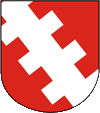mobile View, to the German Version tap the flag


- House of Sponheim (also called Sponheimer or Spanheimer)
- Southern German noble family from the 11th to 15th centuries

to 15th century,
Coat of arms of the Dynasty of Sponheim,
Source, by: Wikipedia (DE)

from 12th century,
Coat of arms of the Dynasty of Ortenburg,
Source, by: Wikipedia (DE)

13th century,
Coat of arms of the Dynasty of the Sponheim Counts Palatine,
Source, by: Wikipedia (DE)

13th century,
Coat of arms of Sponheim-Kreuznach,
Source, by: Wikipedia (DE)

The family of Sponheim (probably a ministerial family of the Salian emperors) is related to that of Sayn-Wittgenstein. There also appear to have been several lines of the von Sponheims: Pfalz-Sponheim, Baden-Sponheim, Sponheim Rear County, Sponheim-Kreuznach etc. The progenitor of the south-east German line, Siegfried I., was himself born in Sponheim around 1010/1015. He came to Carinthia in the course of Emperor Henry III.'s south-east expansion (Bavarian eastern Marches) and became Margrave of the Hungarian Margraviate there. His family subsequently acquired many estates, particularly in Lower Bavaria, Carinthia and Styria. The village of Sponheim – the ancestral seat of the Sponheim family – lies around 10 kilometres west of Kreuznach. The territory of the County of Sponheim extended (somewhat fragmented) in the Bernkastel – Kreuznach – Birkenfeld triangle. The county of Sponheim could be traced back to the 18th century, but has been labelled as belonging to Baden in historical atlases since the 16th century. The coat of arms of the house, first documented in the 11th century, and of the county was a red and white chequered shield. The Sponheim-Kreuznach line originated in the 13th century and used a blue and golden chequered shield. The lateral branch of the Ortenburgs, which originated in the 12th century, used a silver alternating crenellated bar on a red background as the family coat of arms. One line of the Ortenburgs attained the dignity of Count Palatine of Bavaria in the 13th century, but died out in the 13th century. Their coat of arms is the "Sponheim lion". However, it is referred to everywhere as a panther, or better still as a "pantier", as it is in fact a mythical creature or dragon with a red flame in its mouth rather than a red tongue. However, they died out in the middle of the 13th century and the Wittelsbachs inherited or bought the entire Sponheim estate between 1248 and 1259.The "Sponheimer Pantier" was added to the Wittelsbach family coat of arms in 1260. It stood and stands until today for Old Bavaria (south-east Bavaria).
Source: Ronald Preuß, Stephan Gorski, Wikipedia (DE)


![]()





